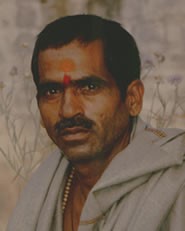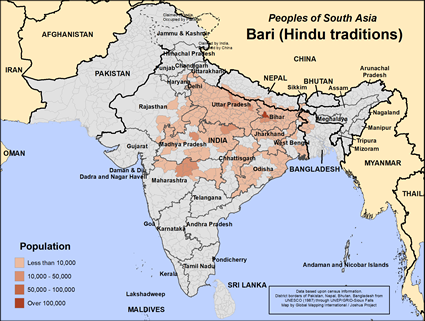The Bari speak Awadhi in Uttar Pradesh, Marathi in Maharashtra, Bhojpuri in Bihar and Mewari in Rajasthan. They speak Hindi also in these states and read and write in Devanagari. Literacy is low. Some live in Nepal.
Bari women help by taking additional work or helping their spouses with their businesses as well as doing the housework and looking after the children.
Most own no land but work in agriculture. Many have small businesses such as cart driving and tailoring. They live in city slums. Child labor is an issue in this culture.
Bari people do not eat beef because of their Hindu religion. They eat wheat, rice and lentils, fruit and vegetables. They drink alcohol, smoke cigarettes and chew tobacco.
Bari only marry within their community. There are many subdivisions. There are clans among them who look after marriage alliances. No one is allowed to marry within their clan. Marriages are mainly monogamous and are arranged by the elders of both families. There are both adult and child marriages. Divorce and remarriage are allowed, but not frequent.
The property of the parents goes equally to all the sons and the oldest son becomes the family leader. The Bari community has their own community welfare association.
The Bari are Hindus and worship most of the Hindu gods like Shiva, Vishnu and Rama. They also worship family and village gods and worship ancestors too. They celebrate Hindu festivals such as Holi, Diwali and Dusshera.
They also celebrate a New Year festival called Makar Sankranti and here sesame seeds combined with jaggery (unrefined sugar) are exchanged among the Bari. They cremate their dead and the ashes are immersed in a river. If they can, they use the Ganges River, which is regarded as holy. Infants to the age of five years old are buried and there is a death pollution period, usually for twelve days with a feast at the end of it.
There are few if any Christ followers among the Bari people. Who will take the life saving gospel to them?
Pray for loving workers to take the gospel message to the Bari community in Nepal.
Pray the Lord will prepare the hearts of the Bari to understand and to believe the gospel.
Pray for the Lord to bless the Bari people with adequate education and medical facilities.
Pray for the Lord to bless the Bari people so abundantly that they will see he is the only one worthy of praise and worship.
Scripture Prayers for the Bari (Hindu traditions) in Nepal.
| Profile Source: Joshua Project |











